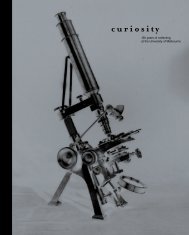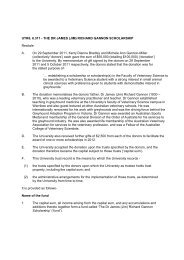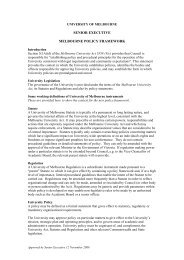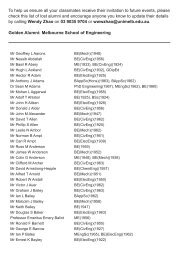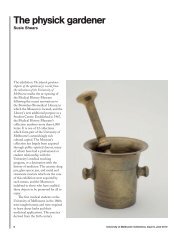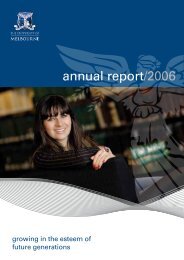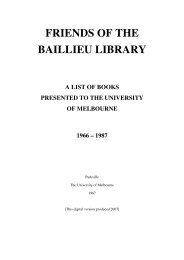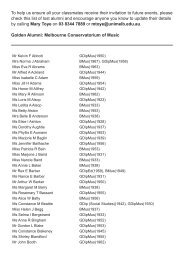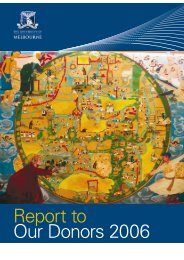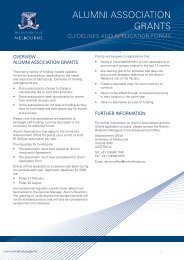2010 International Undergraduate Prospectus nts. u.au
2010 International Undergraduate Prospectus nts. u.au
2010 International Undergraduate Prospectus nts. u.au
Create successful ePaper yourself
Turn your PDF publications into a flip-book with our unique Google optimized e-Paper software.
Did you know?<br />
The Veterinary School is<br />
Australia’s first and we will<br />
be celebrating our centenary<br />
throughout 2009.<br />
The course is internationally<br />
recognised by the American<br />
Veterinary Medical Association,<br />
the Royal College of Veterinary<br />
Surgeons and the Australasian<br />
Veterinary Boards Council Inc.<br />
Please note that <strong>2010</strong> will be<br />
the last entry into the Bachelor of<br />
Veterinary Science (direct entry<br />
only). If you are applying for entry in<br />
<strong>2010</strong> no deferrals will be possible.<br />
From 2011 Veterinary Science will be<br />
offered as a graduate program.<br />
53<br />
Bachelor of Veterinary Science<br />
Duration<br />
4 years full-time<br />
Fees<br />
See page 104<br />
Campus<br />
Parkville and Werribee Campus<br />
Entry requireme<strong>nts</strong><br />
See pages 119–127<br />
About the Bachelor of<br />
Veterinary Science<br />
Stude<strong>nts</strong> wishing to commence their studies<br />
in <strong>2010</strong> will need to enter the three-year<br />
New Generation Bachelor of Science<br />
degree and complete an Animal Health and<br />
Disease major Q (Veterinary Bioscience<br />
specialisation). Entry to the Animal Health<br />
and Disease major Q (Veterinary Bioscience<br />
specialisation) at third year level will be<br />
quota-limited, and it is expected that<br />
stude<strong>nts</strong> will need to excel in their studies at<br />
first and second year level to be selected.<br />
Selection into the Veterinary Bioscience<br />
specialisation is made at the end of second<br />
year of the BSc. Once selected though,<br />
stude<strong>nts</strong> who successfully complete all<br />
third year subjects will have guaranteed<br />
progression to the Doctor of Veterinary<br />
Medicine Q degree.<br />
The new veterinary curriculum will include<br />
integrated and clinically based studies from<br />
the first year of the program, as well as a full<br />
year of workplace experiential learning in the<br />
final year.<br />
Q Pending Academic Board approval<br />
Careers<br />
As a graduate of the course you will have<br />
>>acquired the technical competence<br />
to work with animals, their pathogens,<br />
diseases, welfare and management<br />
>>developed skills in problem definition<br />
and solution, in decision-making and in<br />
program design and implementation<br />
>>developed the ability to organise<br />
knowledge and ideas systematically,<br />
discriminate between relevant data, and<br />
generalise safely<br />
>>developed leadership skills and an ability<br />
to interact effectively and communicate<br />
with professional colleagues, individuals<br />
and the general community<br />
>>learnt to understand the rights, privileges<br />
and responsibilities of membership<br />
of learned societies and professional<br />
associations<br />
>>developed the ability to work and make<br />
decisions under pressure.<br />
Employment opportunities for new<br />
graduates are excellent, with most<br />
graduates employed immediately on<br />
graduation or shortly thereafter. You<br />
could go on to specialise in small animal<br />
medicine, equine or farm animal practice,<br />
or focus on exotic animals, wildlife,<br />
laboratory animals or poultry. There<br />
are also opportunities in other walks<br />
of life, including universities, research<br />
establishme<strong>nts</strong>, pharmaceutical companies<br />
and government service across the globe.<br />
To find out some of the diverse careers our<br />
graduates have pursued, visit ‘Graduate<br />
Stories’ on our website at: www.muvs.<br />
unimelb.edu.<strong>au</strong>/grad_stories/<br />
Course structure<br />
First year: (24 weeks at 26 hours per week)<br />
Normal body function; introduction to the<br />
veterinary profession<br />
>>Anatomy 1A and 1B<br />
>>Physiology 1A and 1B<br />
>>Biochemistry A and B<br />
>>Animal Health Management and Welfare<br />
1A and 1B<br />
>>Veterinary Professional Studies.<br />
Second year: (24 weeks at 29 hours<br />
per week), Normal function continued;<br />
introducing the abnormal; the clinical<br />
approach to health and disease<br />
>>Anatomy 2<br />
>>Physiology 2<br />
>>Pharmacology and Toxicology A and B<br />
>>Animal Health Management and Welfare<br />
2A and 2B<br />
>>Pathology A and B<br />
>>Microbiology A and B<br />
>>Parasitology A and B<br />
>>Introduction to Veterinary Clinical<br />
Sciences.<br />
Third year: (26 weeks at 35 hours per<br />
week) Clinical medicine and surgery;<br />
diseases of body systems (Semester 1);<br />
health, welfare and production by species<br />
(Semester 2)<br />
>>Animal Health Management and Welfare 3<br />
>>Clinical Medicine and Surgery, Diseases<br />
of Body Systems 1<br />
>>Diseases of Body Systems 2<br />
>>Dogs, Cats and Miscellaneous Pets 1<br />
>>Pigs<br />
>>Horses 1<br />
>>Cattle 1<br />
>>Small Rumina<strong>nts</strong> 1<br />
>>Professional Practice 1 (Hospital).<br />
Fourth year: (26 weeks at 39 hours per<br />
week), Continues health, welfare and<br />
production by species (Semester 1); clinical<br />
practice electives as ‘Trainee Veterinarian’<br />
(Semester 2)<br />
>>Dogs, Cats and Miscellaneous Pets 2<br />
>>Horses 2<br />
>>Cattle 2<br />
>>Small Rumina<strong>nts</strong> 2<br />
>>Birds and Non-Domestic Animals,<br />
Professional<br />
>>Practice 2 (Hospital)<br />
> >Professional Practice 3 (Electives) W.<br />
W In Professional Practice 3, you can choose specific areas<br />
of clinical practice.



